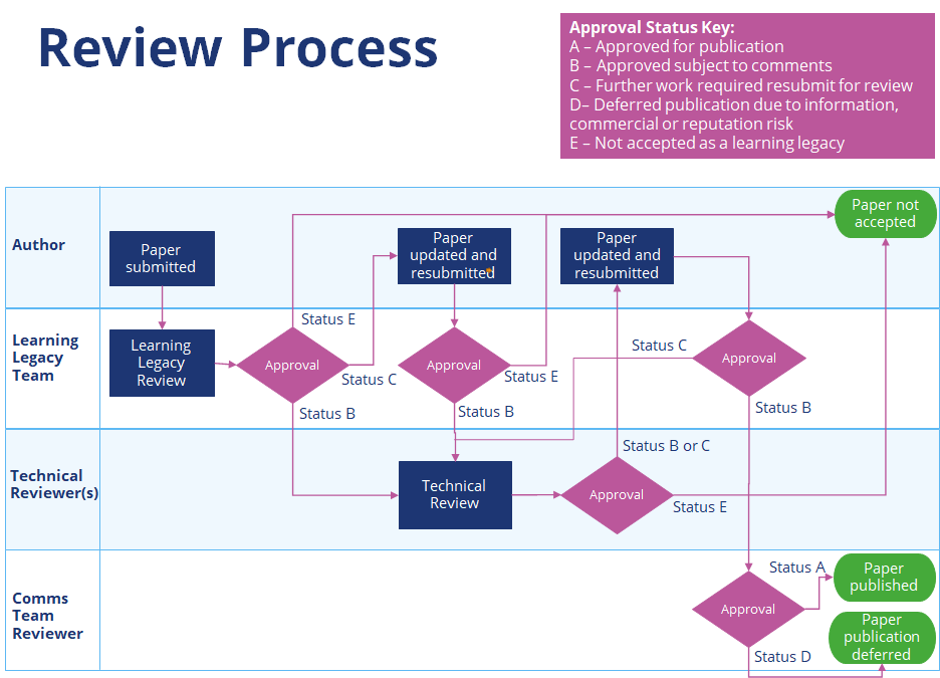How to submit a Learning Legacy resource for publication
There are 3 routes to submitting a learning legacy resource:
- A formal Learning Legacy Challenge
- A Technical Papers Competition
- The ‘Always Open’ Challenge
Formal Challenges and Competitions
Learning Legacy Challenges and Technical Papers Competition are structured campaigns to collect good practice, innovation and lessons learned around a particular theme or phase of the programme. These are run regularly by the HS2 Learning Legacy team in partnership with other HS2/IPT business sponsors.
A forward look of upcoming challenges is shown in the table below. This is indicative and may change in line with the programme milestones.
| Year | Challenge Title | Challenge Key |
|---|---|---|
| 2020 | Technical Papers Competition 2020 | Captured content on technical excellence and learning |
| 2021 | Safe at heart | Captured lessons learned, good practice and innovation on health, safety and well being |
| 2021 | Preparing the Ground | Captured learning, good practice and innovation from the early works prior to the commencement of main works |
| 2022 | Technical Papers Competition 2022 | Captured content on technical excellence and learning |
| 2023 | Construction and Safe at heart | Captures learning, good practice and innovation about the construction of Phase One with a focus on key learning about health, safety and well being |
| 2024 | Environment, Innovation and Design | Captures learning, good practice and innovation on environment, innovation and design |
| 2025 | Technical Papers Competition 2025 | Captures content on technical excellence and learning |
| 2026 | Construction and Safe at heart | Captures learning, good practice and innovation within the construction phases with a focus on key learning about health, safety and well being |
| 2027 | Environment, Innovation and Design | Captures learning, good practice and innovation on environment |
| 2028 | Technical Papers Competition 2028 | Captures content on technical excellence and learning |
A call for papers is published on the Innovation Hub and is communicated via HS2 internal communications, supply chain communications and engagement through team meetings. Authors can then submit their learning legacy at these times.
The process for submitting papers via a Competition or Challenge is detailed in Figure 2.

Author guidance can be found for Learning Legacy Challenges and Technical Papers Competitions.
Open Challenge
The Open Challenge is to capture learning legacy resources that fall outside the remit of, or timeline for, the formal Learning Legacy Challenges and Technical Papers Competition.
Authors submit their learning legacy summary/abstract to the Learning Legacy Team for review and acceptance via the online survey form. Email the learning legacy team [email protected] to be given the link to the form.
All submissions will be collated on a monthly basis. The team then engage with technical reviewers across HS2 to assess the submission against the following criteria for acceptance:
- Is there justification for submission of the learning legacy outside of the usual Challenge/Competition programme?
- Does the learning legacy meet the technical criteria that:
- The outcomes must be known
- There a learning legacy that is transferrable to industry
- The learning legacy is from the HS2 project
- The author must have worked on the HS2 Project
If accepted the Learning Legacy Manager will send the author a link to the Learning Legacy Development Hub to upload their content and add the associated metadata.
The submission process is detailed in Figure 2:

Author guidance for Open Challenges on how to create a learning legacy resource is the same as for the formal Learning Legacy Challenges.
Step by step guidance on how to upload your resource and complete the metadata fields on the Learning Legacy Development Hub can be downloaded here.
Review, Edit and Approval to Publish
Once your paper or resource has been submitted (through any of the above routes), the review process will be initiated. You may be requested to update your paper to address any review comments, after which the paper will be circulated for approval to publish.
The Review, Edit and Approval Procedure is shown in Figure 4.

For Technical Papers Competitions there is also a parallel process in which the papers are scored by the technical reviewers as part the of the Competition. Moderators assign the final collated score which determines the shortlist for judging by independent judges.
